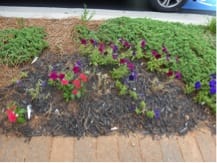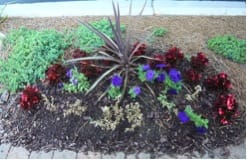Info taken from the UGA publication Crop Rotation and Cultural Practices Help Reduce Diseases in Seasonal Color Beds by Bodie Pennisi, Department of Horticulture and Jean Woodward, Department of Plant Pathology
 Seasonal color plantings can often appear healthy and beautiful one day and absolutely awful several days later. Total collapse at planting is not uncommon. Even though the chief culprit may be a particular disease, there are usually multiple causes at the root of the problem, all leading to plant demise.
Seasonal color plantings can often appear healthy and beautiful one day and absolutely awful several days later. Total collapse at planting is not uncommon. Even though the chief culprit may be a particular disease, there are usually multiple causes at the root of the problem, all leading to plant demise.
Landscapers can reduce disease pressure in color beds by proper care:
-

Figure 2. Mixed planting and improper crop rotation in two consecutive years. The petunias are exhibiting signs of disease in the first year (upper photo) as well as the second year (lower photo). Choose plants suited to the sun and light conditions at the site. See this list of annuals with preferred growing conditions.
- Prepare the soil in the beds to ensure both adequate water retention and drainage by incorporating several inches of organic matter each year.
- Install annuals at a proper depth to avoid stressing root systems.
- Remove old materials and spent blooms as much as possible to reduce disease inoculum.
- Use water sensors on irrigation systems to provide water when it is needed, not on a specific schedule.
- Choose water delivery methods, such as spray emitters directed at the base of plants, soaker hoses and drip irrigation, that will keep foliage dry.
Avoid planting the same species and cultivar of flowering crop, or crops belonging to the same family, in the same bed for more than two years. For example, petunias should not be followed with petunias because certain pathogens specific to petunias tend to accumulate and persist in the soil from year to year (Figure 2). Additionally, if ornamental tobacco is planted after petunia, it still could lead to plants being attacked by the same pathogens because the crops are closely related. This is of particular concern if the petunias were experiencing problems in the first year, which means that the pathogen is already in the soil and in sufficient quantity to cause damage.
Use the following list to select plants from different families to plant in successive years:
| Common annual flowering species and their corresponding botanical family. | |
| Family Name | Common Name of Flowers |
| Amaranthaceae | Celosia (Spike Celosia, Cockscomb), Alternanthera (Joseph’s Coat) |
| Apiaceae | Parsley |
| Apocynaceae | Vinca (Periwinkle) |
| Araceae | Caladium, Alocasia, Colocasia (Elephant Ears) |
| Asteraceae | Aster, Marigold, Gazania, Mums, Sunflower, Black-eyed Susan, Echinacea, Zinnia, Mexican Sunflower, Melampodium, Ageratum |
| Balsaminaceae | Impatiens |
| Begoniaceae | Begonia |
| Brassicaceae | Alyssum, Ornamental Cabbage, Kale |
| Caryophyllaceae | Dianthus |
| Commelinaceae | Setcresea (Purple Heart) |
| Convolvulaceae | Potato Vine (Ipomoea), Morning Glory |
| Crassulaceae | Sedum |
| Geraniaceae | Geranium |
| Goodeniaceae | Scaevola (Fan Flower) |
| Lamiaceae | Coleus, Salvia, Mints |
| Lythraceae | Cuphea (Cigar Plant) |
| Plantaginaceae | Snapdragon |
| Poaceae | Grasses (e.g., Pennisetum) |
| Portulacaceae | Portulaca (Purslane) |
| Rubiaceae | Pentas (Shooting Stars) |
| Scrophulariaceae | Angelonia (Summer Snapdragon), Torenia (Monkey Flower) |
| Solanaceae | Petunia, Ornamental Tobacco, Ornamental Pepper, Browalia |
| Verbenaceae | Verbena, Lantana |
| Violaceae | Pansy, Viola |
Find more information:
Crop Rotation and Cultural Practices Help Reduce Diseases in Seasonal Color Beds
Flowering Annuals for Georgia Gardens
Flowering Bulbs for Georgia Gardens
Native Plants for Georgia Part III: Wildflowers
Success with Mixed Containers Using Perennial and Woody Plants
